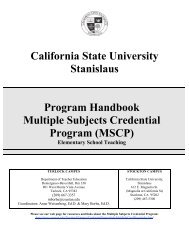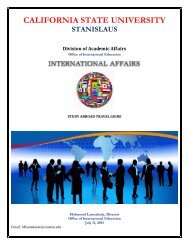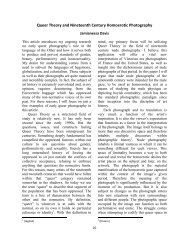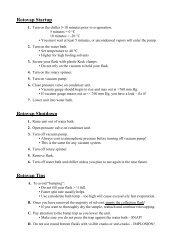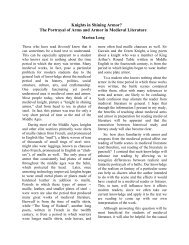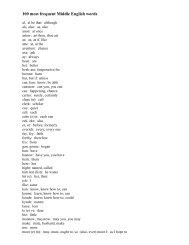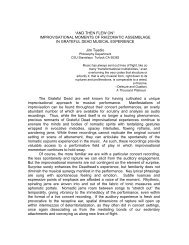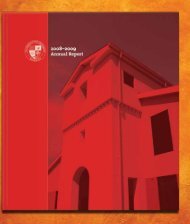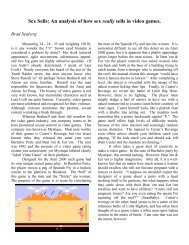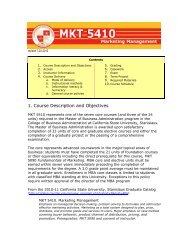Exploring the Benefits of Art in Elementary Education
Exploring the Benefits of Art in Elementary Education
Exploring the Benefits of Art in Elementary Education
Create successful ePaper yourself
Turn your PDF publications into a flip-book with our unique Google optimized e-Paper software.
constructions, experienc<strong>in</strong>g balance as <strong>the</strong>y<br />
build” (Striker, 2001). <strong>Art</strong> <strong>in</strong> itself is separate<br />
from o<strong>the</strong>r areas <strong>in</strong> that it is <strong>the</strong> only subject<br />
that can branch itself out to so many o<strong>the</strong>r<br />
subjects that require <strong>the</strong> very same skills.<br />
However, while <strong>the</strong>re are many similarities<br />
between art and its neighbor<strong>in</strong>g subjects, it<br />
should still be regarded as someth<strong>in</strong>g<br />
completely special all on its own. <strong>Art</strong> should<br />
be appreciated as it provides so much for<br />
young learners.<br />
Joan Bouza Koster also makes <strong>the</strong> claim<br />
that art lends itself to o<strong>the</strong>r areas <strong>of</strong> learn<strong>in</strong>g.<br />
In her book, Grow<strong>in</strong>g <strong>Art</strong>ists: Teach<strong>in</strong>g <strong>Art</strong> to<br />
Young Children (2005), Koster promotes <strong>the</strong><br />
view that “<strong>Art</strong> and o<strong>the</strong>r curriculum areas are<br />
<strong>in</strong>terrelated. <strong>Art</strong> enhances learn<strong>in</strong>g <strong>in</strong> o<strong>the</strong>r<br />
subjects, and activities <strong>in</strong> o<strong>the</strong>r curriculum<br />
areas extend learn<strong>in</strong>g <strong>in</strong> art” (Koster, 2005).<br />
<strong>Art</strong> truly br<strong>in</strong>gs out <strong>the</strong> best <strong>in</strong> children as it<br />
opens <strong>the</strong>ir m<strong>in</strong>ds to everyth<strong>in</strong>g else around<br />
<strong>the</strong>m. The application <strong>of</strong> art to o<strong>the</strong>r subjects<br />
provides a safety zone for students to fall<br />
back on when <strong>the</strong>y are struggl<strong>in</strong>g or to excel<br />
<strong>in</strong> when <strong>the</strong>y understand. In part due to <strong>the</strong><br />
manner <strong>in</strong> which art is graded and judged,<br />
students are more will<strong>in</strong>g to take chances with<br />
art-<strong>in</strong>clusive projects when <strong>in</strong>corporated <strong>in</strong><br />
<strong>the</strong> classroom. Teachers tend to grade art<br />
more leniently and students know this.<br />
Incorporat<strong>in</strong>g art across <strong>the</strong> curriculum can<br />
lower <strong>in</strong>hibitions and put students more at<br />
ease <strong>in</strong> particularly challeng<strong>in</strong>g subjects.<br />
While art provides ano<strong>the</strong>r language for<br />
children as well as be<strong>in</strong>g applicable to various<br />
o<strong>the</strong>r subjects, it also aids <strong>in</strong> physical<br />
development. Robert Schirrmacher argues<br />
that “<strong>Art</strong> activities provide experience and<br />
practice <strong>in</strong> develop<strong>in</strong>g and ref<strong>in</strong><strong>in</strong>g gross<br />
motor or large muscle skills. <strong>Art</strong> <strong>in</strong>volves<br />
physical and manipulative activity. While<br />
easel pa<strong>in</strong>t<strong>in</strong>g, children use <strong>the</strong>ir entire arms<br />
and upper torsos <strong>in</strong> mak<strong>in</strong>g large, sweep<strong>in</strong>g<br />
motions with pa<strong>in</strong>tbrushes” (Schirrmacher,<br />
1998). <strong>Art</strong> helps to facilitate muscle<br />
formation. O<strong>the</strong>r forms <strong>of</strong> art also<br />
59<br />
<strong>in</strong>corporate physical activity. Performance art<br />
helps students by engag<strong>in</strong>g <strong>the</strong>ir bodilyk<strong>in</strong>es<strong>the</strong>tic<br />
learn<strong>in</strong>g styles. Increas<strong>in</strong>g<br />
physical activity helps encourage memory<br />
retention as well. When students perform <strong>in</strong><br />
<strong>the</strong> classroom, not only are <strong>the</strong>y develop<strong>in</strong>g<br />
physically, but <strong>the</strong>y are also <strong>in</strong>creas<strong>in</strong>g <strong>the</strong><br />
chance that <strong>the</strong>y will remember and learn<br />
more effectively.<br />
<strong>Art</strong> Influences Student Behavior. Students I<br />
observe generally vary <strong>in</strong> <strong>the</strong>ir classroom<br />
performance. Students <strong>in</strong> classrooms<br />
<strong>in</strong>corporat<strong>in</strong>g frequent art activities tend to<br />
participate more <strong>in</strong> class. I typically see more<br />
students volunteer<strong>in</strong>g to answer questions <strong>in</strong><br />
classes that promote art. When art is left out,<br />
<strong>the</strong> students are generally more reluctant to<br />
answer questions. I th<strong>in</strong>k this can be<br />
expla<strong>in</strong>ed at least partially by some <strong>of</strong> Elliot<br />
Eisner’s <strong>in</strong>sights. Eisner argues that expos<strong>in</strong>g<br />
kids to multiple perspectives through <strong>the</strong> use<br />
<strong>of</strong> art helps <strong>the</strong>m to become more effective<br />
problem solvers. While most subjects heavily<br />
emphasized <strong>in</strong> schools do not allow for more<br />
than one correct answer, educators still expect<br />
students to answer questions correctly with<br />
ease. However, it has been my observation<br />
that teachers are <strong>of</strong>ten too critical <strong>of</strong> student<br />
answers and some children are genu<strong>in</strong>ely<br />
afraid to ask questions. I believe that <strong>in</strong> artfriendly<br />
classrooms where multiple<br />
perspectives are presented more openly and<br />
frequently, children are more likely to want to<br />
voice <strong>the</strong>ir op<strong>in</strong>ions. Children are likely to be<br />
more productive and have higher success<br />
rates if <strong>the</strong>y are encouraged to participate.<br />
Part <strong>of</strong> this success can be attributed to good<br />
question<strong>in</strong>g strategies, but also <strong>the</strong> <strong>in</strong>clusion<br />
<strong>of</strong> art <strong>in</strong> <strong>the</strong> classroom places emphasis on <strong>the</strong><br />
correctness <strong>of</strong> multiple perspectives.<br />
Clearly <strong>the</strong>re is an abundance <strong>of</strong> benefits<br />
to be had by students <strong>of</strong> all ages. While I<br />
would like to focus on younger children and<br />
<strong>the</strong>ir connection to art, I would also like to<br />
emphasize that art should be cont<strong>in</strong>ued<br />
throughout a student’s school<strong>in</strong>g. <strong>Art</strong>



